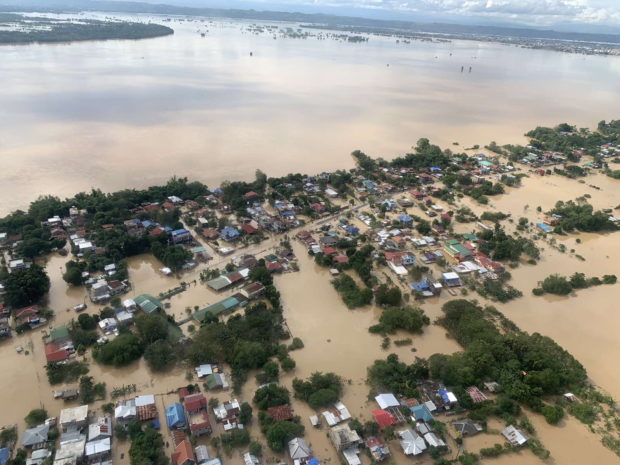What caused Cagayan Valley’s worst flood in 40 years?
MANILA, Philippines — Officials offered various explanations on Saturday for the worst flood to hit Cagayan Valley in 40 years.
Being a catch basin, the water from other provinces and the water released from the Magat Dam flowed toward Cagayan, causing the flood, said Cagayan Gov. Manuel Mamba.
The National Irrigation Administration (NIA) said it has been releasing water from the dam since Nov. 9 ahead of the landfall of Typhoon Ulysses (international name: Vamco) and then opened seven of Magat’s spillway gates to control the reservoir’s overflow at the height of the typhoon.
Wilfredo Gloria, operations manager of the Magat River Integrated Irrigation System, told the Inquirer that the NIA could not completely stop the release of water because that could result in a more massive destruction as the dam’s water level was at a critical point.
He said in a phone interview that five of the spillways had been shut and only two gates remained open on Saturday, discharging 1,355 cubic meters per second of water against an inflow of 1,261 cms per second.

Rescuers from the Philippine Coast Guard reach some of the trapped residents the following day. —PHILIPPINE COAST GUARD PHOTO
Danger of overloading
This is to stabilize the dam’s water level which currently is at 192.19 meters, against the critical level of 193 m, Gloria said.
Article continues after this advertisement“What we want is to normalize the water level at 192 m or at least below 193m, but we should also take into consideration the communities that may be affected by this. So right now, as much as possible, we are trying to stabilize it,” he said.
Article continues after this advertisement“If we overload the reservoir up to 193 meters, it may lose its natural stability. If we overload the dam and that overloading prolongs, the dam may break,” Gloria added.
The irrigation and hydroelectric dam was built in 1982 at the boundary of Alfonso Lista town in Ifugao province and the municipality of Ramon in Isabela. It has a 45-square-kilometer reservoir that is fed by watersheds in Nueva Vizcaya (60 percent), Ifugao (33 percent) and Isabela (7 percent).
The NIA recorded that from Monday to Saturday, the multipurpose dam reservoir had an inflow of 721.28 million cubic meters of water while outflow totaled 578.33 mcm.
Downstream flow
Ed dela Cruz, a hydrologist at the Philippine Atmospheric, Geophysical and Astronomical Services Administration (Pagasa), said the current inflow of water was nearly the same rate as the discharge of water at 1,271 cms—862 cms of water for spilling and 409 cms for power generation.
“The inflow of water to the dam must be lowered so that at least the power generation and the inflow are equal. Then they could close the gates,” he said.
Water continues to stream into the dam from its 4,100-sq-km catch basin, Dela Cruz said.
“Ulysses had a large rain band that reached up to Cagayan and that rainfall is entering the expansive basin,” he said.
Dela Cruz said that another factor that led to the flooding was water from upper parts of Cagayan flowing downstream to Cagayan River.
Mark Timbal, the National Disaster Risk Reduction and Management Council (NDRRMC) spokesperson, said the widespread flooding in Cagayan Valley was not due to the release of the water from Magat Dam, but rather the swelling of Cagayan River over the course of several weeks.
“These flooding incidents are the cumulative effects of the continuous rains experienced in Luzon,” Timbal told the Inquirer.
He explained that there has been “more than a month’s worth of rainy days,” in addition to at least five successive tropical cyclones that soaked the Luzon landmass.
Timbal said rainfall from the previous storms and typhoons have caused all the tributaries of the Cagayan River to swell, causing the flooding. The release of the water from the dam also was a factor.
In October 2015, at least 26 villages in Cagayan were flooded due to water discharged by Magat Dam in Isabela in the aftermath of slow-moving Tropical Storm “Lando” (Koppu) which inundated and caused landslides in many northern and central Luzon provinces.
NDRRMC executive director Ricardo Jalad insisted that the council gave adequate warnings of flooding.
Local gov’ts surprised
He said the agency’s advisories were the same as Pagasa’s “and always highlight the risk of floods,” Jalad told reporters in a Viber message.
He also said that the agencies responsible for risk assessment for hydrometeorological hazard is Pagasa and the Mines and Geosciences Bureau.
Malacañang on Saturday said it was not caught unprepared for the massive flood that rapidly swept through the provinces of Cagayan and Isabela in the wake of Ulysses, even though the local officials were surprised by its unprecedented magnitude.
Many Filipinos who were following disaster relief and rescue operations in areas battered by the typhoon, especially Metro Manila and Rizal province, heard reports of the massive flood in the two northern provinces only late on Friday night and Saturday morning.
But presidential spokesperson Harry Roque said the National Disaster Risk Reduction and Management Council had earlier deployed relief supplies and rescue personnel in the region.
“We were not caught unprepared because what we needed had been prepositioned. We just deployed more air assets to the area,” Roque said in the Laging Handa briefing.
He said the Philippine Coast Guard (PCG) has been rescuing residents in Isabela and Tuguegarao City as early as dawn on Friday.
Early Saturday, the PCG also deployed convoys with a multipurpose vehicle, trucks, buses, newly procured rubber boats and rescue personnel, Roque said.
“The President is on top of the situation,” he added. “He is in constant communication with [Defense] Secretary Delfin Lorenzana and Undersecretary [Ricardo] Jalad of the [NDRRMC].”
In the same briefing, Mamba said the floodwater level rose to 13.1 m, higher than the 11 meters that it had risen to in the past.
“This is unprecedented in Cagayan, this is the first time we experienced this. That’s why many were surprised. But really, we prepared for this, but this is worse than what we prepared for,” Mamba told the Laging Handa briefing.
—With reports from Leila B. Salaverria, Patricia Denise M. Chiu and Inquirer Research
